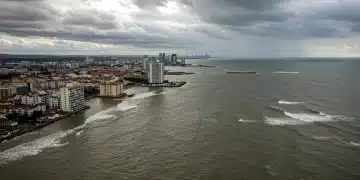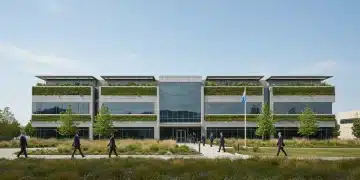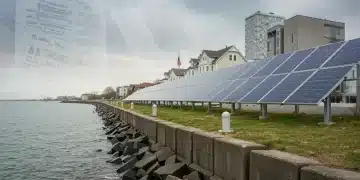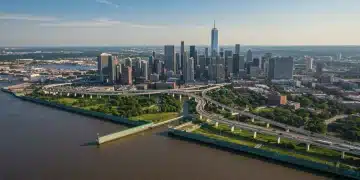Practical Solutions for U.S. Coastal Communities Facing Sea-Level Rise
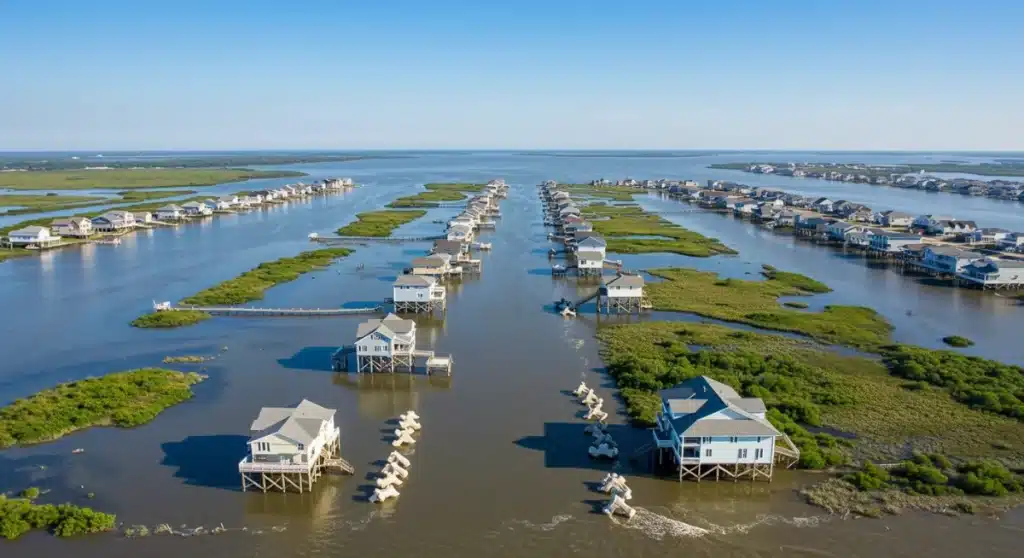
U.S. coastal communities face urgent challenges from projected 2 feet of sea-level rise by 2050, necessitating immediate, practical solutions for adaptation, infrastructure protection, and sustainable development to ensure long-term resilience.
As the specter of a 2-foot sea-level rise by 2050 looms large, Practical Solutions for U.S. Coastal Communities Facing 2 Feet of Sea-Level Rise by 2050 are urgently needed. This critical challenge demands immediate and innovative responses to protect millions of Americans and vital infrastructure from the impending impacts of climate change.
Understanding the Imminent Threat to Coastal Regions
The U.S. coastline is facing an unprecedented threat with projections indicating a 2-foot sea-level rise by 2050. This rise is not a distant problem; it is a current reality that demands immediate attention and strategic planning from federal, state, and local entities. The implications extend far beyond property damage, impacting ecosystems, economies, and public safety.
Recent reports from NOAA and other scientific bodies confirm that the rate of sea-level rise is accelerating. This acceleration means that communities have less time than previously thought to implement effective adaptation strategies. The urgency of the situation cannot be overstated, as inaction will lead to far greater costs and irreversible damage.
Key Drivers of Accelerated Sea-Level Rise
Understanding the primary factors contributing to this accelerated rise is crucial for developing targeted solutions. Global warming continues to be the overarching driver, melting glaciers and ice sheets at an alarming rate, and causing thermal expansion of ocean waters.
- Thermal Expansion: As ocean waters warm, they expand, contributing significantly to sea-level rise.
- Glacial and Ice Sheet Melt: The rapid melting of Greenland and Antarctic ice sheets, along with mountain glaciers, adds vast amounts of water to the oceans.
- Ocean Currents and Land Subsidence: Regional variations in ocean currents and geological processes like land subsidence exacerbate the problem in specific coastal areas.
Infrastructure Adaptation: Fortifying Our Front Lines
Protecting existing infrastructure and developing new, resilient structures are cornerstones of any effective strategy. Many coastal cities were built without considering future sea-level scenarios, making adaptation an expensive yet unavoidable necessity. This involves a combination of engineering solutions and innovative urban planning.
From elevating roads and buildings to constructing advanced flood barriers, communities are beginning to invest in projects designed to withstand higher water levels. These projects often require significant capital investment but offer long-term protection for vital services and economic hubs. The goal is to create a multi-layered defense system that can absorb and deflect the impacts of rising tides and storm surges.
Innovative Engineering Solutions
Engineers are at the forefront of developing groundbreaking solutions to protect coastal assets. These range from traditional hard structures to more dynamic, nature-based approaches. The selection of a solution often depends on the specific geographic and economic context of the community.
- Seawalls and Levees: While controversial due to their environmental impact, these structures offer direct protection for densely populated areas and critical infrastructure.
- Elevated Structures: Building codes are being updated to mandate elevated foundations for new construction and incentivize it for existing properties in flood-prone zones.
- Pervious Pavements and Green Infrastructure: These solutions help manage stormwater runoff, reducing localized flooding and recharging groundwater tables, which can mitigate subsidence.

Nature-Based Solutions: Harnessing Ecosystem Power
Beyond concrete and steel, nature itself offers powerful defenses against sea-level rise. Restoring and preserving coastal ecosystems can provide effective, sustainable, and often more cost-effective protection than purely engineered solutions. These approaches work with natural processes to enhance resilience.
Mangrove forests, salt marshes, and oyster reefs act as natural buffers, absorbing wave energy, reducing erosion, and filtering water. These ecosystems also provide critical habitats for marine life and support local economies through fisheries and tourism. Integrating these natural elements into coastal defense plans is becoming increasingly recognized as a vital component of a holistic strategy.
Restoration and Conservation Efforts
Several initiatives are underway to restore degraded coastal ecosystems and protect existing ones. These projects often involve collaboration between government agencies, environmental organizations, and local communities, highlighting the importance of a multi-stakeholder approach.
For instance, significant efforts are being made to re-establish oyster reefs along the Gulf Coast and restore salt marshes in the Northeast. These projects not only provide physical protection but also contribute to biodiversity and ecological health. The long-term benefits of such investments far outweigh the initial costs, offering a sustainable path forward.
Policy and Planning: Guiding Future Development
Effective policy and robust planning frameworks are essential to guide coastal communities through the challenges of sea-level rise. This includes updating zoning laws, land-use regulations, and building codes to reflect future climate realities. Proactive planning can prevent maladaptation and ensure resources are allocated efficiently.
Relocation and managed retreat, while difficult conversations, are becoming increasingly necessary considerations for some highly vulnerable areas. Policies must support these transitions, providing assistance and new opportunities for affected residents and businesses. This requires a delicate balance between protection, adaptation, and strategic withdrawal.
Adaptive Management Strategies
Adaptive management is a key principle in coastal planning, recognizing that climate conditions are dynamic and solutions must evolve. This involves continuous monitoring, evaluation, and adjustment of strategies based on new data and changing circumstances. Flexibility is paramount in the face of uncertainty.
- Zoning and Land-Use Regulations: Updating these to restrict development in high-risk areas and promote resilient construction practices.
- Incentive Programs: Offering financial incentives for property owners to elevate homes, implement nature-based solutions, or participate in voluntary relocation programs.
- Community Engagement: Ensuring local residents are involved in the planning process to foster understanding, build consensus, and tailor solutions to specific community needs and values.
Economic Implications and Funding Mechanisms
The economic impact of sea-level rise is profound, affecting property values, insurance markets, and local economies. Funding mechanisms are critical for implementing the necessary protective and adaptive measures. This requires a combination of federal, state, and local investments, alongside private sector engagement.
Innovative financing models, such as resilience bonds and public-private partnerships, are emerging to help bridge the funding gap. The cost of inaction far surpasses the cost of proactive measures, making these investments economically sound in the long run. Ensuring equitable access to funding for all communities, regardless of their economic standing, is also a significant challenge.
Securing Sustainable Funding
Identifying and securing consistent funding streams is one of the biggest hurdles for coastal communities. Federal programs, while vital, often require matching funds from states or localities, which can be challenging for smaller communities with limited tax bases. New approaches are needed to make resilience affordable for all.
For instance, some states are exploring dedicated climate resilience funds, financed through various mechanisms like bond issues or a portion of property taxes. These funds provide a stable source of capital for long-term projects. Additionally, federal grants, like those from FEMA and HUD, are crucial for post-disaster recovery and pre-disaster mitigation efforts, but often fall short of total needs.
Community Engagement and Social Equity in Adaptation
Successful adaptation to sea-level rise is not just about engineering and policy; it heavily relies on robust community engagement and ensuring social equity. Solutions must be developed with, not for, the residents who will be most impacted. This means involving diverse voices in decision-making processes and addressing historical injustices.
Vulnerable populations, including low-income communities and communities of color, often bear a disproportionate burden of environmental risks and have fewer resources to adapt. Ensuring that adaptation strategies benefit all residents and do not exacerbate existing inequalities is a moral and practical imperative. Transparency and inclusive participation are key to building trust and achieving equitable outcomes.
Empowering Local Voices
Empowering local communities to lead their own adaptation efforts can result in more effective and culturally appropriate solutions. This involves providing resources, technical assistance, and training to local leaders and residents. Grassroots initiatives often offer insights that top-down approaches might miss.
- Participatory Planning: Engaging residents in workshops, public meetings, and citizen science programs to gather local knowledge and preferences.
- Capacity Building: Providing training and resources to local governments and community organizations to enhance their ability to plan, implement, and manage resilience projects.
- Equitable Resource Distribution: Prioritizing funding and support for communities most at risk and those with limited capacity to self-fund adaptation measures.
| Key Solution Area | Brief Description |
|---|---|
| Infrastructure Adaptation | Fortifying existing structures and building new, resilient infrastructure like elevated roads and advanced flood barriers to withstand rising sea levels. |
| Nature-Based Solutions | Restoring and preserving coastal ecosystems such as mangroves and salt marshes to act as natural buffers against erosion and storm surges. |
| Policy and Planning | Updating zoning laws, land-use regulations, and building codes to guide future development and consider managed retreat where necessary. |
| Community Engagement | Ensuring diverse community voices are included in decision-making, providing equitable resources, and fostering local leadership in adaptation efforts. |
Frequently Asked Questions About Coastal Resilience
U.S. coastal communities are projected to experience approximately 2 feet of sea-level rise by 2050. This projection is based on current climate models and observed trends, indicating a significant and accelerating threat requiring immediate action and strategic planning.
Nature-based solutions, such as restoring mangrove forests, salt marshes, and oyster reefs, provide natural buffers. They absorb wave energy, reduce erosion, filter water, and provide critical habitats. These methods are often more sustainable and cost-effective than traditional hard infrastructure.
Policies and planning frameworks are crucial for guiding resilient development. This includes updating zoning laws, land-use regulations, and building codes to reflect future climate risks. They also help manage retreat from highly vulnerable areas and ensure equitable resource distribution for adaptation projects.
The economic challenges include decreasing property values, increasing insurance costs, and damage to vital infrastructure. Financing adaptation measures requires substantial investment, often through resilience bonds, public-private partnerships, and federal grants, ensuring equitable access across communities.
Community engagement ensures that adaptation solutions are developed with, and are appropriate for, the affected residents. It promotes social equity by involving diverse voices, addresses historical injustices, and builds trust, leading to more effective and sustainable long-term resilience strategies for all.
Looking Ahead: The Path to Resilient Coasts
The imperative for Practical Solutions for U.S. Coastal Communities Facing 2 Feet of Sea-Level Rise by 2050 is clear and immediate. What happens next involves a sustained, collaborative effort across all levels of government, private industry, and local communities. The focus must shift from reactive responses to proactive, integrated strategies that prioritize long-term resilience and social equity. Expect to see continued legislative efforts, increased funding allocations, and accelerated implementation of both engineered and nature-based solutions as the impacts of sea-level rise become more pronounced. This is an ongoing battle, and vigilance, coupled with innovation, will be our strongest defense.
